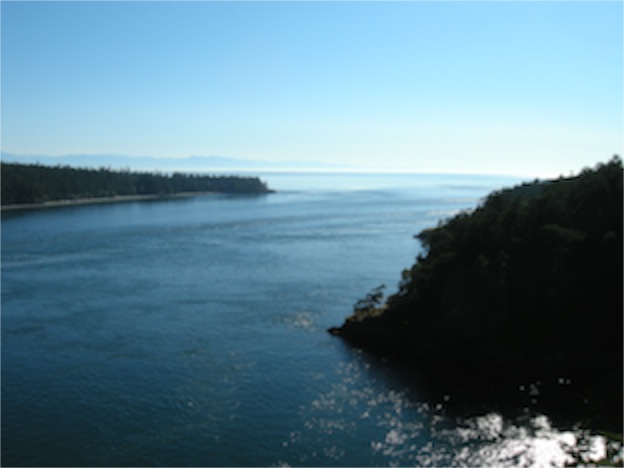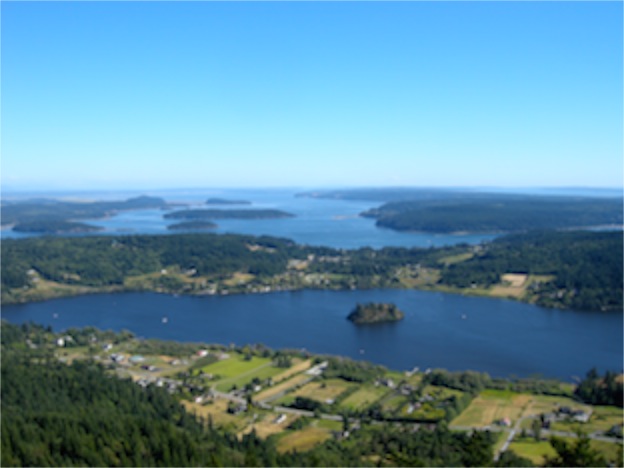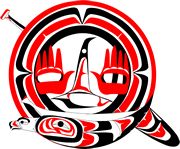Island life
14/07/13 06:54
The northern Puget Sound has been the home of coastal Salish tribes for thousands of years. The area was first visited by European explorers in 1790, when the Spanish were exploring the West Coast of the Americas. The island where we are staying is called Fidalgo Island and it gets its name from Salvador Fidalgo, who was a member of that 1790 Spanish expedition. The English also contributed a lot of names for the places that are in use today. The Vancouver expedition arrived in June of 1792 and a group of sailors from that expedition, led by Joseph Whidbey mapped and gave place names to the Islands of the region. The largest island bears his name. At first, however, the explorers didn’t realize that Whidbey was an island. They thought that it was a peninsula. The narrow channels that separate Fidalgo Island from the mainland and Whidbey Island from Fidalgo were at first not noticed. It was George Vancouver himself who gave the name “Deception Pass” to the channel that separates Fidalgo and Whidbey Islands.
 These days, the islands are connected to the mainland by bridges. Highway 20 has a bridge from the mainland to Fildago and a bridge across Deception Pass to Whidbey Island. Actually, it takes two bridges to span Deception Pass as there is a large rock, called Pass Island between the two islands. The waters in the pass are turbulent and at low water can produce large standing waves. The area is one of incredible natural beauty and the ocean is abundant in producing food. The Salish people were able to make a good living gathering clams and other shellfish and fishing for the plentiful fish of the nearby waters.
These days, the islands are connected to the mainland by bridges. Highway 20 has a bridge from the mainland to Fildago and a bridge across Deception Pass to Whidbey Island. Actually, it takes two bridges to span Deception Pass as there is a large rock, called Pass Island between the two islands. The waters in the pass are turbulent and at low water can produce large standing waves. The area is one of incredible natural beauty and the ocean is abundant in producing food. The Salish people were able to make a good living gathering clams and other shellfish and fishing for the plentiful fish of the nearby waters.
I am not an Island person. I have lived my life in the center of the continent, surrounded by prairies and mountains and miles and miles of land between me and the ocean. Most of the world’s people, however, live in coastal regions. Coastal regions support higher populations and the United States, like other regions of the world has higher populations at its coasts. Not being from this place gives me a particular way of looking at the area and its people.
There are several features of the land that surprise and delight me as I tour this area. The islands are large enough to have their own mountains and there are freshwater lakes nestled among the rolling hills. Here on Fidalgo Island the highest point is Mount Erie. We journeyed to the top of the mountain where there are views in several different directions. The mountain is home to rainforest with giant Cedar, Hemlock and Douglas Fir trees. The trees grow all the way to the top of the mountain, so you have to find just the right spot to get a view. When you do get a view, it is spectacular.
 There are at least eight lakes on Fidalgo Island. There is a very good view of Campbell Lake from Mt. Erie. Right in the middle of Campbell Lake is a small, wooded island. The idea of an island in a lake on an island is rather intriguing. From the top of Mt. Erie, there are good views of several of the islands that make up the San Juan chain. Most of the Islands do not have bridge access and are accessed by boats. The Washington State Ferry system provides regular service to the islands. People who live on the islands have adapted to the schedules and have learned that traveling to and from their home requires a bit of extra time. The relative isolation of island life has a similar quality to the isolation of small towns on the prairie where people have to travel many hours to get to a city. A relatively isolated lifestyle in a place of great natural beauty rich with varied food sources is something that the people of the prairie share with their distant cousins living on islands.
There are at least eight lakes on Fidalgo Island. There is a very good view of Campbell Lake from Mt. Erie. Right in the middle of Campbell Lake is a small, wooded island. The idea of an island in a lake on an island is rather intriguing. From the top of Mt. Erie, there are good views of several of the islands that make up the San Juan chain. Most of the Islands do not have bridge access and are accessed by boats. The Washington State Ferry system provides regular service to the islands. People who live on the islands have adapted to the schedules and have learned that traveling to and from their home requires a bit of extra time. The relative isolation of island life has a similar quality to the isolation of small towns on the prairie where people have to travel many hours to get to a city. A relatively isolated lifestyle in a place of great natural beauty rich with varied food sources is something that the people of the prairie share with their distant cousins living on islands.
If you study a map of the Black Hills, you realize that the hills are an island as well. Instead of being surrounded by the ocean, however, they are surrounded by the flatlands of western prairie. There are miles of open prairie that separate the Black Hills from the other mountains of the Rocky Mountain range. And the hills have developed their own ecology in the midst of this isolation, with a unique variation on the spruce tree known as Black Hills spruce. The resident animals also have unique variations from their cousins in other areas. Black Hills mule deer tend to be smaller than those of the main Rockies and the populations of elk and bighorn sheep have also developed some unique characteristics from living isolated from the larger herds found elsewhere throughout the west.
We have the great luxury of being able to travel from one environment to the other. Unlike the explorers of the great European expeditions of the late 18th century, we are able to make multiple visits within a single lifetime. We have the luxury of exploring the territory with the knowledge that we will likely return. The beauty and the charm of the islands have attracted many repeat visitors. Their popularity as a destination is evidenced by the many tourists we encounter everywhere we go.
 We are enjoying the hospitality of the Samish Nation, staying at a resort that is owned and operated by the tribe. The Samish people range from the Cascade Mountains to the coastal and island areas. Their heritage includes and emphasis on communal living and the traditional longhouses housed multiple families under the same roof. I have much to learn about the traditions and culture of the native people, but their way of life is distinctive and fascinating. Here at the resort are several large cedar canoes and later today there is a special festival celebrating the arrival of a canoe from another island. The Samish people also erected totem poles. There are also displays of Samish artwork around the area.
We are enjoying the hospitality of the Samish Nation, staying at a resort that is owned and operated by the tribe. The Samish people range from the Cascade Mountains to the coastal and island areas. Their heritage includes and emphasis on communal living and the traditional longhouses housed multiple families under the same roof. I have much to learn about the traditions and culture of the native people, but their way of life is distinctive and fascinating. Here at the resort are several large cedar canoes and later today there is a special festival celebrating the arrival of a canoe from another island. The Samish people also erected totem poles. There are also displays of Samish artwork around the area.
I do not live in the era of the great expeditions to explore the world, but I am privileged to live in a time when I can do a little exploration on my own. Along the way I am encountering not only beautiful places, but also interesting people. I hope that I can offer them a bit more respect than did those early explorers.

I am not an Island person. I have lived my life in the center of the continent, surrounded by prairies and mountains and miles and miles of land between me and the ocean. Most of the world’s people, however, live in coastal regions. Coastal regions support higher populations and the United States, like other regions of the world has higher populations at its coasts. Not being from this place gives me a particular way of looking at the area and its people.
There are several features of the land that surprise and delight me as I tour this area. The islands are large enough to have their own mountains and there are freshwater lakes nestled among the rolling hills. Here on Fidalgo Island the highest point is Mount Erie. We journeyed to the top of the mountain where there are views in several different directions. The mountain is home to rainforest with giant Cedar, Hemlock and Douglas Fir trees. The trees grow all the way to the top of the mountain, so you have to find just the right spot to get a view. When you do get a view, it is spectacular.

If you study a map of the Black Hills, you realize that the hills are an island as well. Instead of being surrounded by the ocean, however, they are surrounded by the flatlands of western prairie. There are miles of open prairie that separate the Black Hills from the other mountains of the Rocky Mountain range. And the hills have developed their own ecology in the midst of this isolation, with a unique variation on the spruce tree known as Black Hills spruce. The resident animals also have unique variations from their cousins in other areas. Black Hills mule deer tend to be smaller than those of the main Rockies and the populations of elk and bighorn sheep have also developed some unique characteristics from living isolated from the larger herds found elsewhere throughout the west.
We have the great luxury of being able to travel from one environment to the other. Unlike the explorers of the great European expeditions of the late 18th century, we are able to make multiple visits within a single lifetime. We have the luxury of exploring the territory with the knowledge that we will likely return. The beauty and the charm of the islands have attracted many repeat visitors. Their popularity as a destination is evidenced by the many tourists we encounter everywhere we go.

I do not live in the era of the great expeditions to explore the world, but I am privileged to live in a time when I can do a little exploration on my own. Along the way I am encountering not only beautiful places, but also interesting people. I hope that I can offer them a bit more respect than did those early explorers.